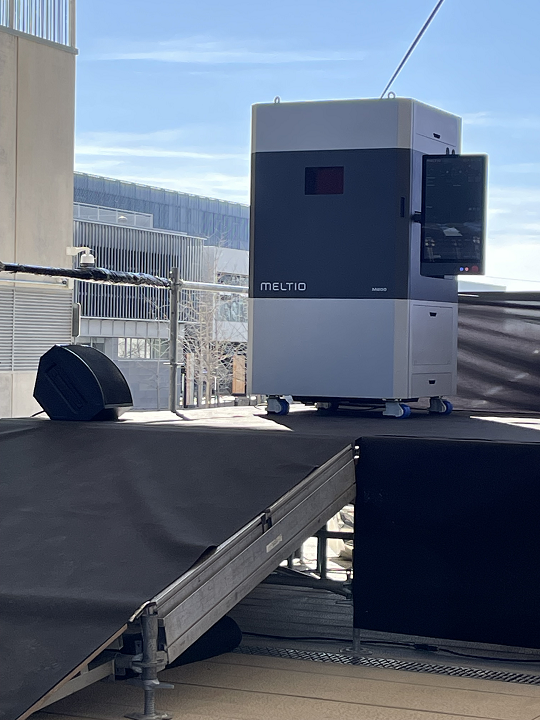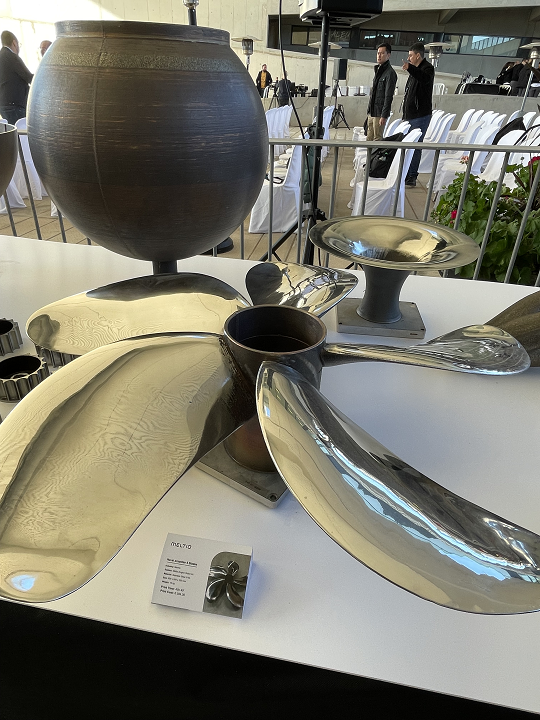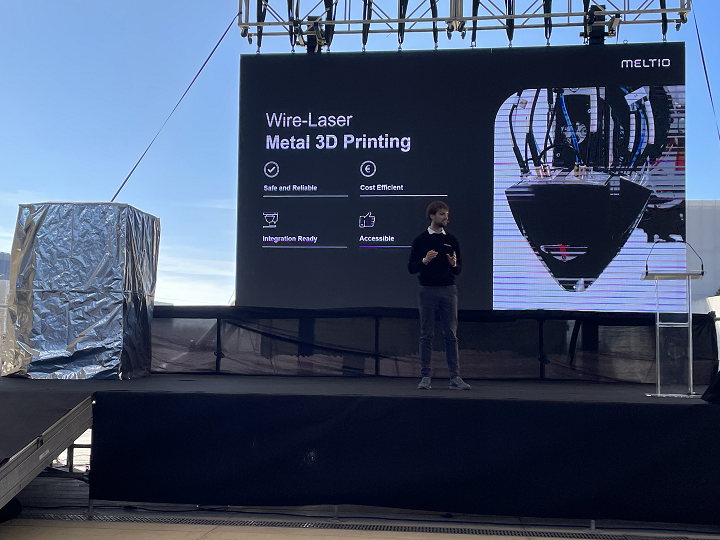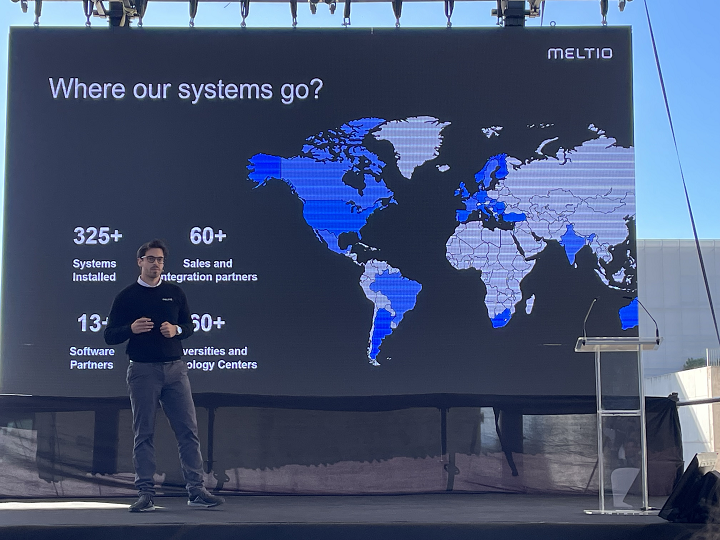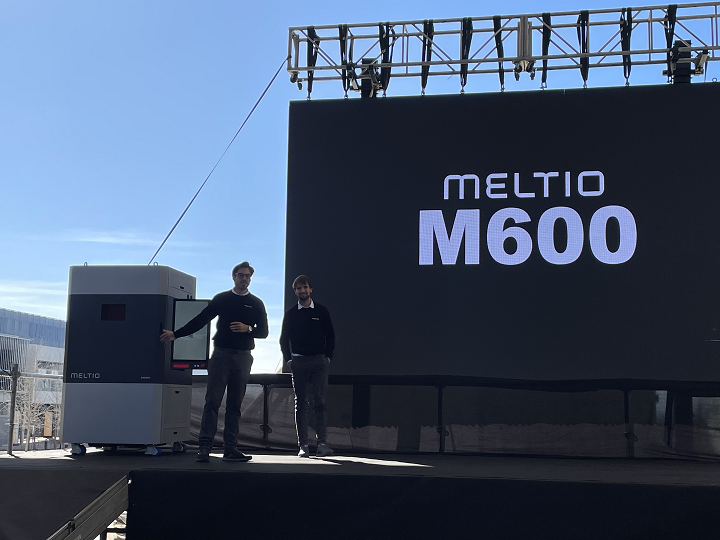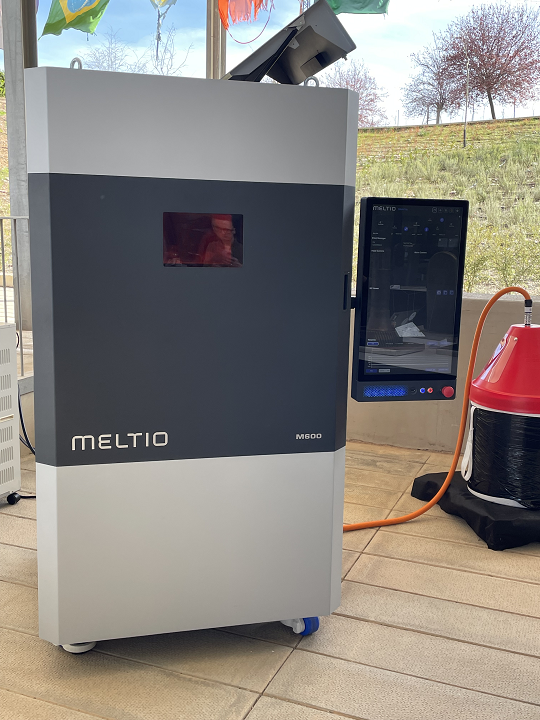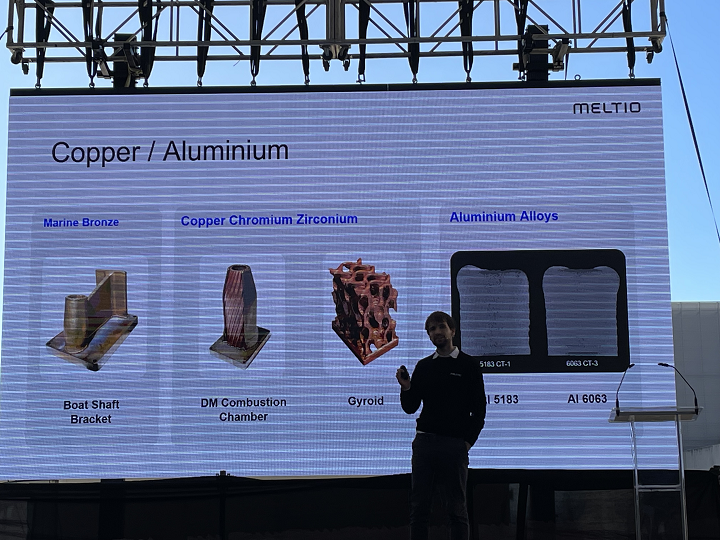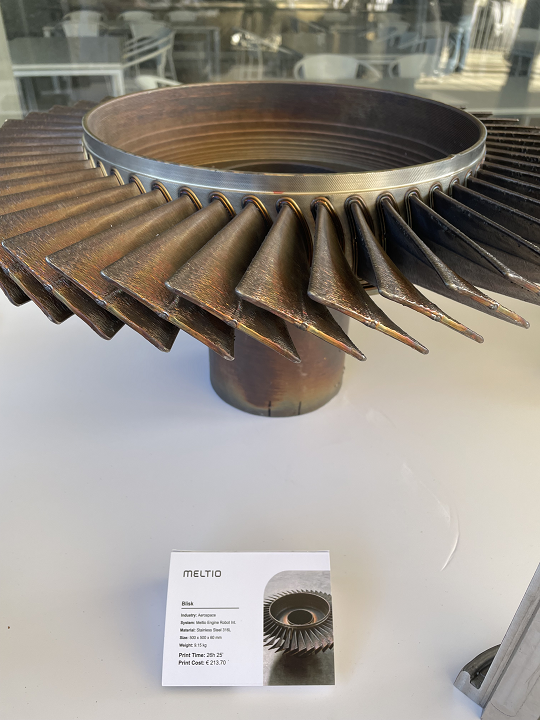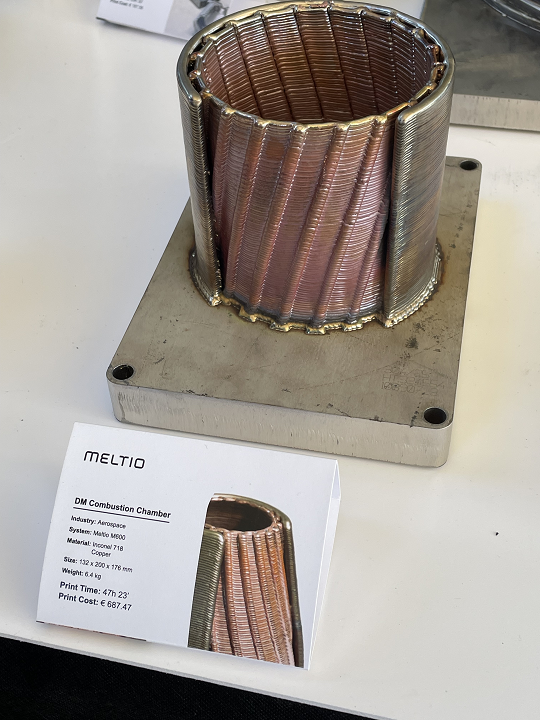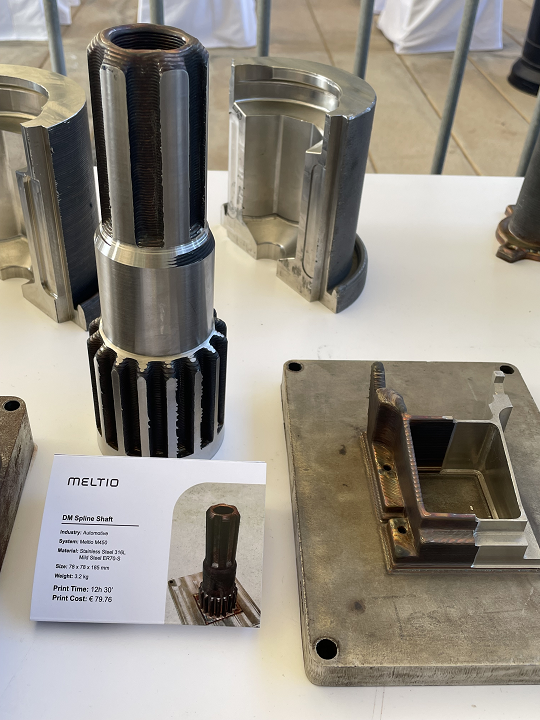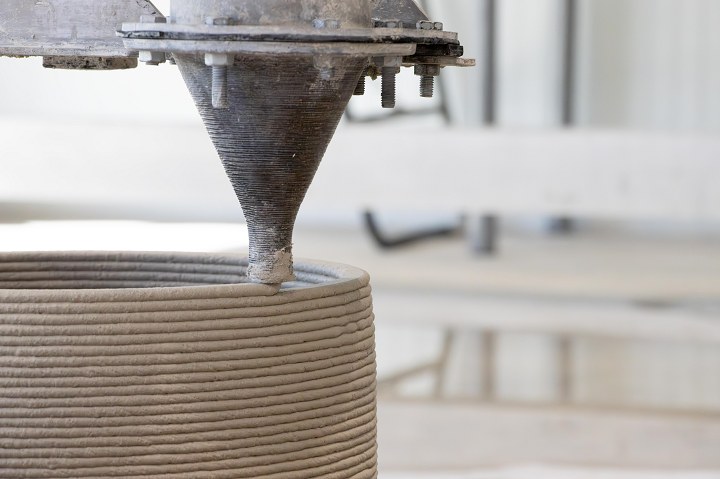Founded in 2019 as a joint venture between Additec and Sicnova, metal 3D printer OEM Meltio develops and manufactures high-performance and easy-to-use metal 3D printing solutions that use its patented wire-laser metal deposition (LMD) technology, which is a type of DED. The company is based in Linares, Spain, and that’s where I was last week, attending the launch of its new industrial 3D printer: the Meltio M600.
Let’s get the basics out of the way: this new system combines wire deposition, smart sensors, a larger 300 x 400 x 600 mm fully inert workspace, and blue lasers to print even more demanding metals, including, Inconel, nickel, stainless steels, titanium, and copper and aluminum alloys.
The M600 was developed to be the perfect complement to modern machine shops, using its 3-axis touch probe and support for multiple workholding solutions (like zero-point clamping) to print and repair parts, as well as add features to existing components. Plus, the printer was designed to be very autonomous, as well as easy to use. That’s why the tagline for the event was “Plug, Press Play, & Print.”
In his welcome speech to the gathered journalists and resellers from around the world, Meltio’s CEO Ángel Llavero said that the M600 is the “second generation” of the turn-key M450 3D printer, which was released in 2019.
“The first wasn’t the perfect solution, so we listened to your problems and made a very, very good product,” he said about the new printer.
The official launch event for the next-generation Meltio M600 was also live-streamed to AMUG 2024 in Chicago.
“We’re not going to be another company that is focused on powder bed fusion processes. We’re going to only focus on laser wire deposition,” Lukas Hoppe, R&D Director at Meltio, told the assembled crowd about the company’s history and mission.
Hoppe explained that wire-laser AM is cost-efficient, accessible, integration-ready, safe, and reliable. Meltio wanted to prove with its original M450 that “laser wire deposition could be an easy process,” and that plug-and-play metal AM was possible. While it wasn’t easy at first to develop and fine-tune the company’s turnkey machine for near net shape printing, the company succeeded.
“It took over three years of problem solving to achieve a stable printing process for our current technology, and two more years to get to where we are today,” he continued. “In these five years, the fundamental concept and setup of our machine hasn’t changed. It’s the same lasers, the same dials.”
Meltio and its users learned a lot from this initial machine, including the fact that reliability is the most important aspect above anything else; understanding process dynamics is key; and the printer itself is only part of the solution. The whole ecosystem is necessary for success.
“It’s about the software, finding local support for your machine, material parameters, all of these things that need to come together. And if you don’t have all of these, then you’re not going to be able to sell a solution that the market really needs,” Hoppe said.
Then, Meltio Engine Project Manager Alejandro Jiménez took the stage to introduce the Meltio ecosystem, made up of the following:
- Meltio M450
- Meltio Engine CNC Integration
- Meltio Engine Robot Integration
- Meltio Engine Robot Cell
- Meltio M600
“We had just nine people and one proven concept in 2019, and now we’ve developed more than 16 solutions with a group of 100+ people,” Jiménez told the crowd.
In addition to the machines themselves, the company’s ecosystem includes global partners, local support teams, software, and 65 resellers that support Meltio from around the globe.
In terms of its software solutions (Meltio Horizon slicer and Meltio Space), Jiménez announced that the company was introducing Meltio Horizon 1.4, and Dashboard, a web-based cloud platform for print monitoring, management, and more. Then, Jiménez and Hoppe together officially unveiled the new Meltio M600 to thunderous applause.
“This is the machine we consider to be a game-changer for the way metal parts are produced all around the world,” Hoppe said. “This machine is completely new. The only thing it shares with any of our existing products is that it also uses the laser wire deposition process. Everything else has been changed.”
The new Meltio M600 was imagined to be the ideal 3D printer for the machine shop, designed to provide a solution for fragile supply chains, long lead times, and expensive stock. Hoppe explained that a main reason the M600 is meant for machine shops is post-processing.
“3D printed metal parts always need to be post-processed through conventional manufacturing methods,” he continued. “You will never have a 3D printer, at least in the foreseeable future, where you just take out your finished components. This post-processing, be it for industry or production, will always happen in the machine shop. So the printer should end up in the machine shop.”
The printer was conceived to move metal AM outside of niche areas, and introduce the technology to industrial production. Welding wire as a feedstock is cheaper and safer, and won’t risk contaminating CNC machines, which makes it a great candidate for integration into machine shops and onto the factory floor.
As Hoppe explained, the printer is fully inert and able to print parts of 300 x 400 x 600 mm, and also features a wire drum connection kit and built-in 3 axis touch probe, the latter of which is used to add features onto existing parts. It has a vision system, factory-calibrated deposition head, and can resume printing if power is lost, thanks to full linear encoders. Plus, as the company mentions in its press release, the M600 can print 24/7 with only minimal operator interaction for autonomous production. It also features high-quality servo motors and ball screws for minimal maintenance, a dehumidifier to maintain constant ambient conditions, and a built-in filtration system.
Using wire LMD, users can print high-quality components with material properties that are comparable to what you’d achieve using conventional manufacturing, but with safer materials. This was one of the qualities Meltio knew would be important to machine shops, along with workholding and hybrid manufacturing, high productivity, ease of use and fast to program, a small footprint with a large workspace, minimal maintenance, competitive cost per kg of material, and a wide range of approved materials.
Speaking of new materials, the M600 can process marine bronze, 5K and 6K series aluminum alloys, super duplex stainless steel and M7 steel, and copper chromium zirconium (CuCrZr), which is a demanding material to print but has great mechanical properties; Meltio actually prints the nozzles for its printers in this material. Hoppe said that aluminum alloys are good for printing large parts, but the resolution isn’t as high. Though he did assure the audience that “this is something we are working on.” It’s important to note that, while the CuCrZr and aluminum alloys have been deemed printable on the M600, they’re not available yet, as testing is still being conducted.
The printer’s blue laser deposition head is what actually enables the use of these new materials. It’s even more special because it uses no fibers: the lasers are integrated directly into the head. Most industrial lasers emit near-infrared light, but the 450 nm blue lasers in Meltio’s new printer reduce energy consumption, due to increased absorption of short wavelength light. The company says these lasers improve efficiency and increase speed, allowing the M600 to print 60% faster than the first-generation M450, and achieve an annual throughput of 3,200 kg. That equals roughly 30,000 watch bezels, 125 spline shafts, and 1,060 boat brackets.
Meltio also claims that its blue laser deposition head, which features new and improved sensors for print monitoring, is aligned at the factory, thanks to energy distribution and wire guidance, and so no operator adjustment is needed between material changes; again, plug-and-play metal AM. Obviously, if this is really true, output from the printer will be more consistent and maintenance will be reduced.
“With this printer, we’ve been able to shift a little bit how the energy is delivered, and able to improve a little bit how the wire is delivered. Because of these two tweaks, we’ve actually managed to make a printer that can come factory-calibrated. You don’t have to touch it, and it will always work,” Hoppe said. “This removes all the variants between the prints. You have one printer that will be exactly the same if I set it up, if Alejandro sets it up, right? So this is a big step forward.”
The final portion of the M600 launch presentation focused on the printer’s “real success story.” Spanish cement company Cementos La Cruz develops 3D printing solutions for construction, as well as low-carbon footprint cementitious materials. The company, which is focused on the circular economy, has adopted Meltio’s technology to print metal parts, and specifically used the M600 to fabricate a stainless steel nozzle that enables the manufacturing of more sustainable cement parts.
High control of material flow is required for typical AM, but it’s even more crucial in additive construction. A printer’s nozzle is key to achieving high-quality layers, and Cementos La Cruz recognized that a 3D printable design would be best to create the kind of nozzle they wanted. Using Meltio’s wire LMD technology, the company was able to print nozzles that optimize the quality of layers, along with controlling the deposition of the concrete.
While the system itself was impressive, the overall event was also a success due not only to how the machine was presented, but in the various ways that the Meltio team was able to educate the attendees. As you’ll learn in a follow-up article, we were able to get into the fine details of the M600 and the surrounding ecosystem through a series of special breakout sessions that gave us new insights into the technology.
Subscribe to Our Email Newsletter
Stay up-to-date on all the latest news from the 3D printing industry and receive information and offers from third party vendors.
Print Services
Upload your 3D Models and get them printed quickly and efficiently.
You May Also Like
Consolidation in AM: How 2025 Is Shaping the Industry’s New Normal
The first half of 2025 has been marked by a clear shift in the additive manufacturing (AM) industry. Companies are no longer just focused on developing new tech by themselves....
Etsy Design Rule Change Reduces Selection of 3D Printed Goods
Online marketplace Etsy has implemented a rule change requiring all 3D printed goods on the site to be original designs. The update to the site’s Creativity Standards states, ¨Items produced using...
U.S. Congress Calls Out 3D Printing in Proposal for Commercial Reserve Manufacturing Network
Last week, the U.S. House of Representatives’ Appropriations Committee moved the FY 2026 defense bill forward to the House floor. Included in the legislation is a $131 million proposal for...
Transforming From Tourist to Native: Duro CEO Michael Corr Explains Why the Company Rebuilt its PLM Software on AI
In these early innings of the AI boom, many market analysts have expressed concern that AI spend has gotten too far ahead of the technology’s proven ability to deliver significant...


